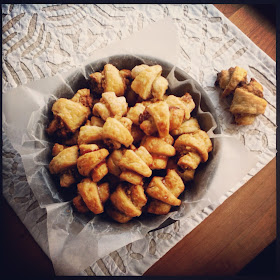The time has come for cider. Warm cider on chilly afternoons. Big gulps of cold cider after a long jog through the falling leaves. A splash of cider in a tumbler of bourbon. I don't really need to convince you on this subject, right?
Because I am a) still fiendish for cider right now and b) still loving my
homebrewed kombucha like nobody's business, it seemed only natural to make a cider-riffic version of my favorite fizzy drink. I really can't think of a more perfect match than tart kombucha and sweet-sour apples. Throw in a few sticks of cinnamon and a hearty glug of maple syrup, and this is officially something special.
You could definitely make a shortcut version by mixing some cider into a glass of plain kombucha, but I really love using fresh apples. Play around with different varieties — tart and juicy Macintosh apples have been my personal favorite so far. This is also a good way to use up those last few bruised and battered fruits that have been lingering in the back of the fridge for too long.
And because I know you were wondering: yes, try this with a shot of bourbon. Fall-time whiskey sour, anyone? Yes, please.
Apple Cider Kombucha
Makes about a gallon (can be halved, as pictured)
14 cups water
1 cup white granulated sugar
4 bags black tea (or 1 tablespoons loose tea)
4 bags green tea (or 1 tablespoon loose tea)
2 cups starter tea from last batch of kombucha or
store-bought (unpasteurized, neutral-flavored) kombucha
1 scoby
2 apples (pick ones that you like to eat)
2 cinnamon sticks
4 whole cloves
4 tablespoons maple syrup or honey
Bring the water to a boil. Remove from the heat and stir in
the sugar to dissolve. Drop in the tea and allow it to steep until the water
has cooled. Depending on the size of your pot, this will take a few hours. You
can speed up the cooling process by placing the pot in an ice bath.
Remove the tea bags or strain out the loose tea. Stir in the
starter tea. Pour the mixture into a 1-gallon glass jar and gently place the scoby on top
with clean hands. Cover the mouth of the jar with a few layers of cheesecloth
or paper towels secured with a rubber band.
Keep the jar at room temperature, out of direct sunlight, and where it won’t
get jostled. Ferment for 7 to 10 days, checking the kombucha and the scoby
periodically. It’s not unusual for the scoby to float at the top, bottom, or
even sideways. A new cream-colored layer of scoby should start forming on the
surface of the kombucha within a few days.
After 7 days, begin tasting the kombucha daily by pouring a
little out of the jar and into a cup. When it reaches a balance of sweetness
and tartness that is pleasant to you, the kombucha is ready to bottle.
With clean hands, gently lift the scoby out of the kombucha
and set it on a clean plate. Measure out 2 cups of starter tea from this batch of
kombucha and set it aside for your next batch.
Dice the apples into small bits and add them to a clean 1-gallon jar along with the cinnamon, cloves, and maple syrup (or divide these ingredients evenly between smaller jars if you don't have a second 1-gallon jar). Pour the fermented kombucha over top. Cover the mouth of the jar with several layers of cheesecloth or paper towels secured with a rubber band. Keep the jar at room temperature out of direct sunlight for 2 days.
Strain and discard the apples and spices. Bottle the infused kombucha into two clean 2-liter soda bottles (or several smaller bottles). Leave at least 1 inch of headspace in the bottles.
Store the bottled kombucha at room temperature out of direct
sunlight until carbonated, typically 1 to 3 days, depending on the
temperature of the room. When the bottles
feel rock-solid with very little give, they’re ready. Refrigerate to
stop carbonation and then consume within a month.
Prepare your next batch of kombucha right after bottling the
previous batch. Combine the reserved starter tea with a fresh batch of sugary
tea, and pour it into the cleaned fermentation jar. Slide the scoby on top,
cover, and proceed with fermentation.




















































